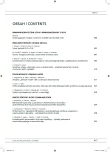The Occurrence of “Typical” MRI Findings in Progressive Supranuclear Palsy and Multiple System Atrophy – a Retrospective Pilot Study
Authors:
Z. Grambalová; P. Hluštík; M. Heřman; P. Kaňovský
Authors‘ workplace:
Centrum pro diagnostiku a léčbu neurodegenerativních onemocnění, Neurologická klinika LF UP a FN Olomouc
Published in:
Cesk Slov Neurol N 2010; 73/106(5): 538-541
Category:
Short Communication
Overview
Objectives:
Conventional MRI findings are usually normal in patients with Parkinson’s disease, whereas they are believed to reveal characteristic abnormalities in patients with other parkinsonian syndromes. This difference provides a potential for using objective neuroradiological criteria in differential diagnosis.
Methods:
In this pilot study, MRI examinations of the brain were retrospectively assessed in 10 patients (7 females, 3 males: aged 59-71, mean 65 ± 4.2 years) suffering from PSP (6 patients) and MSA (4 patients), confirmed through clinical, laboratory, electrophysiological and CSF findings. The areas of midbrain tegmentum and pons were inspected with particular attention and the following “typical” MRI signs were sought: “morning glory” sign, “hot cross bun” sign, “panda face” sign and “standing penguin silhouette“ sign, as well as hypo- or hyperintensities in the posterolateral putamen (in T2 and FLAIR images).
Results:
In all the patients with PSP, the “standing penguin silhouette” appeared, while the “morning glory” sign was observed in only one patient with PSP. In contrast, all patients with MSA had hypo- and hyperintensities in the posterolateral putamen in T2 and FLAIR scans. The “hot cross bun” sign was found in one patient.
Conclusion:
We confirmed the presence of midbrain atrophy as a typical neuro-imaging feature (“standing penguin silhouette”) in PSP. The “standing penguin silhouette” appears to be more sensitive than the “morning glory” sign. Patients with MSA manifested signal changes in the posterolateral putamen in T2 and FLAIR images instead.
Key words:
magnetic resonance imaging – parkinsonian syndromes – multiple system atrophy – progressive supranuclear palsy
Sources
1. Golbe LI, Davis PH, Schoenberg BS, Duvoisin RC. Prevalence and natural history of progressive supranuclear palsy. Neurology 1988; 38(7): 1031–1034.
2. Gilman S, Low PA, Quinn N, Albanese A, Ben-Shlomo Y, Fowler CJ et al. Consensus statement on the diagnosis of multiple system atrophy. J Auton Nerv Syst 1998; 74(2–3): 189–192.
3. Seppi K. MRI for the differential diagnosis of neurodegenerative parkinsonism in clinical practise. Parkinsonism Rela Disord 2007; 13 (Suppl 3): S400–S405.
4. Takao M, Kadowaki T, Tomita Y, Yoshida Y, Mihara B. “Hot-cross bun sign” of multiple system atrophy. Intern Med 2007; 46(22): 1883.
5. Nicoletti G, Fera F, Condino F. Brain magnetic resonance imaging in multiple-system atrophy and Parkinson disease. Arch Neurol 2002; 59: 835–842.
6. Adachi M, Kawanami T, Ohshima H, Sugai Y, Hosoya T. Morning glory sign: a particular MR finding in progressive supranuclear palsy. Magn Reson Med Sci 2004; 3(3): 125–132.
7. Steele JC, Richardson JC, Olszewski J. Progressive supranuclear palsy. A heterogeneous degeneration involving the brain stem, basal ganglia and cerebellum with vertical gaze and pseudobulbar palsy, nuchal dystonia and dementia. Arch Neurol 1964; 10: 333–359.
8. Warmuth-Metz M, Naumann M, Csoti I, Solymosi L. Measurement of the midbrain diameter on routine magnetic resonance imaging: a simple and accurate method of differentiating between Parkinson disease and progressive supranuclear palsy. Arch Neurol 2001; 58(7): 1076–1079.
9. Oba H, Yagishita A, Terada H, Barkovich AJ, Kutomi K, Yamauchi T et al. New and reliable MRI diagnosis for progressive supranuclear palsy. Neurology 2005; 64(12): 2050–2055.
10. Gröschel K, Kastrup A, Litvan I, Schulz J. Penguins and hummingbirds: midbrain atrophy in progressive supranuclear palsy. Neurology 2006; 66(6): 949–950.
11. Kato N, Arai K, Hattori T. Study of the rostral midbrain atrophy in progressive supranuclear palsy. J Neurol Sci 2003; 210(1–2): 57–60.
Labels
Paediatric neurology Neurosurgery NeurologyArticle was published in
Czech and Slovak Neurology and Neurosurgery

2010 Issue 5
- Metamizole vs. Tramadol in Postoperative Analgesia
- Memantine in Dementia Therapy – Current Findings and Possible Future Applications
- Memantine Eases Daily Life for Patients and Caregivers
- Metamizole at a Glance and in Practice – Effective Non-Opioid Analgesic for All Ages
- Advances in the Treatment of Myasthenia Gravis on the Horizon
Most read in this issue
- Pudendal Neuralgia – a Case Report
- Development of the PLIF and TLIF Techniques
- Cubital Tunnel Syndrome – a Review of Surgical Treatments and Comparison of their Outcomes
- Gunshot Wounds of the Head and Brain
